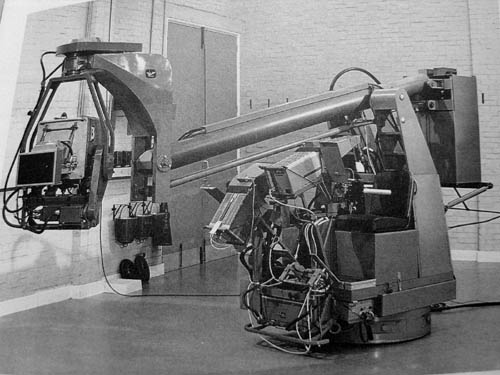| This has become a growing project since Roger Francis sent me the drawings further down the page. The Vinten Peregrine was a failed experiment in camera crane technology. Designed to a BBC spec, it was delivered to Television Centre in 1965. The idea was to build a camera crane that would fit on the footprint of a Vinten ped, but have the range of a Mole (MPRC) crane and the flexibilty of a Vinten Heron. It was designed to carry a standard sized mid-sixties monochrome camera equipped with an Angenieux zoom. It lasted a very short time and was hardly used at all. I saw it demonstrated on Tomorrows World whilst I was still at school - and next saw it stored in the corner of the TC mechanical workshop, where mostly it stayed. Why was it a failure? Well, take a large machine operated by clunky early sixties servos, give it enormous flexibilty of movement controlled by two people who are looking mostly at monitors low down in front of them, and you tend to have an clumsy and somewhat dangerous elephant in the crowd. And the fact that when left overnight in TC5 it made a big round dent in the floor didn't help either. It was always going to make a comeback from storage, but it never did, and presumably was eventually broken up. This is it, in a picture sent by Paul Ewing. 
Before Paul sent the picture, I hunted the internet for one, and found an entry in the special collections of the University of Houston, Texas. A Dr. Tom Battin, an American pioneer of educational tv, had died in 1976, leaving a lot of his effects to the university. Near the bottom of the last box is a film - "The Vinten Peregrine Camera Crane BBC TV Enterprise, undated". I contacted Richard Dickerson at the library, who kindly loaned me a DVD copy of the film, and here it is. It appears to be a Vinten recut of the main BBC experimental session, a section of Macbeth, with director Michael Hayes providing a commentary. At the end there are credits, but in typical BBC fashion none for the camera crew. Given that in this particular case they are the only people who really matter, it's quite astonishing from this distance in time, though not if you were there. So, after 43 years, I'd like to say that the cameraman was Stan Appel, and the tracker - who is seen more often in this - was John Cavacuiti. |